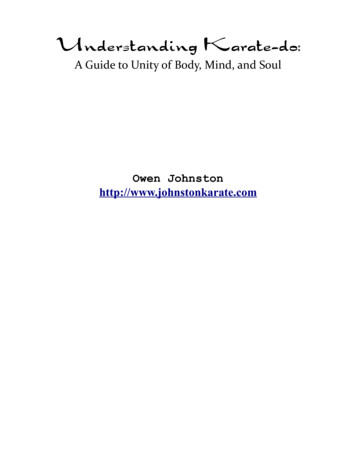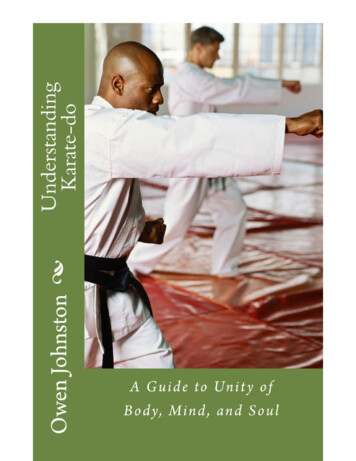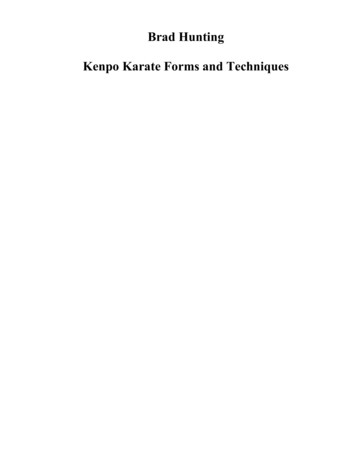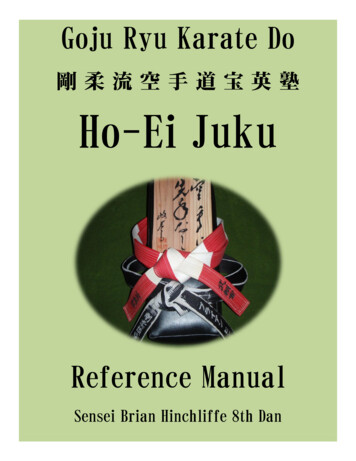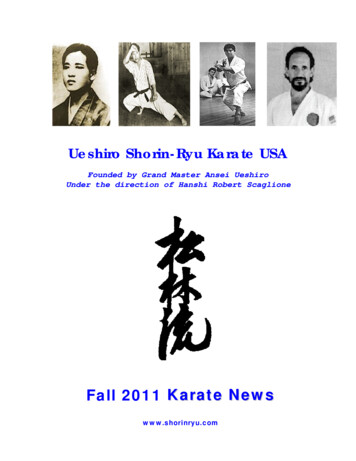
Transcription
Okinawan Shuri Ryu Karate ManualLast Updated: 10/13/2015
Shuri Ryu KaratedoOkinawan Shuri Ryu KaratedoShu : To Learn From Tradi!onRi : To Transcend or Go BeyondRyu : Style or Par!cular School of ThoughtThe roots of Shuri-Ryu are in Okinawa, especially in the Shuri-Te karate of Ankoh Itosu andChoki Motobu and the Hsing Yi Chuan of Tung Gee Hsing. Robert Trias, the style’s founder,trained with Tung Gee Hsing, who had cross-trained with Choki Motobu earlier in the Okinawan village of Kume Mura. Tung Gee Hsing taught Trias Hsing Yi (the “Intellectual” Fist)and Shuri Karate Kempo.Later Trias studied with Hoy Yuan Ping, Gogen Yamaguchi, Roy Oshiro, Yasuhiro Konishi,Makoto Gima, and several other teachers. Konishi awarded Trias with the 9th Dan in 1964and was a prominent student of both Choki Motobu and Gichin Funakoshi. Gima was aprominent student of Funakoshi and awarded Trias the 10th Dan in 1983. Both, Konishiand Gima helped Trias reconstruct the old Shuri-Te system of Okinawan karate with somemodifica!ons, hence a new name for the system was designated Shuri-Ryu. Shuri-Ryu alsoincorporated some Naha katas and methods.Robert Trias, the first person to teach karate in the United States in 1945 in Phoenix, Arizona. He opened the first karate school in the na!on in 1946 and formed the first karate organiza!on, the United States Karate Associa!on, in 1948. Other styles of karate related tothe Trias-line are Shorei-Goju-Ryu and Shorei-Ryu. In addi!on to the punches, blocks, andkicks of karate, Shuri-ryu also incorporates joint locks, take-downs and throws, and kobudo(tradi!onal weapons).Shuri-ryu also has several short combina!ons. These include: 26 ippons (ippon kumite kata), which are performed to develop form and power; 10 taezus (taezu naru waza) whichare performed to develop speed and fluidity; 30 kihons which are performed to developfigh!ng technique; and 8 sente mo!ons (thousand hands techniques). In addi!on, thereare addi!onal training exercises including form sparring (kata kumite), focus stance sparring (kime dachi kumite), free exercise (jiju undo), and free sparring (jiju kumite). One ofiden!fying features of Shuri-ryu is the use of the Shuri fist in lieu of a standard fist. Insteadof curling the index finger when making the fist, the index finger is laid flat, and the thumbpushes down on the finger, resul!ng in a !ghter fist. Another feature of Shuri-ryu is the posi!on of the thumb of the knife edge strike or block. The thumb and forefinger form a “j”so that the hand may be used in a variety techniques (ridgehand, spearhand, open-handthroat strikes, etc.) without changing the thumb posi!on.
Robert TriasRobert A. Trias (1923–1989) was a U.S. karate pioneer, founding the first karate school in the mainland United States. He also developed Shuri-ryu karate, an eclecƟc style with roots in the Okinawan Shurite tradiƟon.Life Before KarateTrias was employed by Southern Pacific Company as a boilermaker appren!ce from 1937–39 and a boilermaker from 1939-42.Introduc!on to KarateWhile serving in the United States Naval Reserve as a Metalsmith First Class (M1c) during World War II, Robert Trias was sta!oned on or around Tulagi in the Solomon Islands from June 1944 to November 1945, andwas a Navy champion middleweight boxer. There he met Tung Gee Hsiang, a Chinese missionary of Chan(Zen) Buddhism. Hsiang oKen watched Trias work out and imitated his boxing footwork, and he asked toprac!ce with Trias. Trias refused because Hsiang was "just a !ny liMle guy," but Hsiang was persistent and atlast Trias agreed to spar with him. Hsiang gave Trias "the biggest thrashing of his life" and Trias then askedHsiang to instruct him in the mar!al arts.Hsiang taught Trias some xingyiquan as well as some Okinawan Shuri-Te karate, which Hsiang had learnedfrom Choki Motobu in Okinawa. Later, Trias studied with Hoy Yuan Ping whose lineage was from the TeshinShinjo School of Kempo Jujutsu in Japan. Trias also held a 6th dan black belt in Kodokan Judo,and studied under Yaju Yamada. Trias was also mentored by Yasuhiro Konishi and Makoto Gima.Karate in the U.S.In late 1945, shortly before Trias leK the Navy in January of the following year, he began teaching mar!al artsin his backyard. He later opened the first karate school in the United States mainland in Phoenix, Arizona in1946. Trias served as an officer of the Arizona State Highway Patrol from 1946-1961u!lizing his self-defenseknowledge on duty and teaching his fellow officers. In 1948 he founded the United States Karate Associa!on (USKA), the first karate organiza!on on the US mainland. Through his pioneering efforts in Karate, hebecame the United States' liaison with Korea, Japan, China, and Okinawa for many years. Jointly with JohnKeehan, Trias hosted the first actual na!onal karate tournament, called the 1st World Karate Tournament, atthe University of ChicagoFieldhouse in 1963 in Chicago, IL. This event was re!tled the USKA Na!onals in 1966and the USKA Grand Na!onals in 1968.His rules for tournament compe!!on are s!ll used today with onlyslight varia!on.Trias' style was known as Shorei-Goju ryu, Shorei-ryu and Shuri-ryu. Many US organiza!ons claim to tracetheir roots to him and the USKA, including the United States Karate-Do Kai, Professional Karate Commission,United States Karate Alliance, Interna!onal Shuri-Ryu Associa!on, and Kondo No Shokai.
Career AccomplishmentsRobert Trias was responsible for the following accomplishments in developing karate in United States:1955 - Wrote the first rules for karate compe!!on.1955 - Conducted the first karate tournament.1958 - Wrote the first textbook.1959 - Made the first instruc!onal film.1963 - Conducted the first world karate championships.1968 - Conducted the first professional karate tournament.Death and LegacyTrias died on July 11, 1989 of cancer leaving the Shuri-ryu system to his daughter Roberta Trias-Kelley, inheritor of Shuri-Ryu and Menkyo Kaiden, and precipita!ng a struggle for succession within the USKA.] Trias is buried in Sec!on 35, Site 112 of the Na!onal Memorial Cemetery of Arizona in Phoenix.Robert A. Trias (1923-1989), known by some as "the father of Karate in America", founded the first karateschool in Arizona. He developed Shuri-ryu karate with its roots in the Okinawan tradi!on.While serving in the United States Navy during World War II, Robert Trias was sta!oned in the Solomon Islands. There he met Tong Gee Hsing, a Chinsese missionary of Chan (Zen) Buddhism, who offered to teachTrias some mar!al arts in exchange for lessons in American boxing. Hsing became O'Sensei's teacher andtaught him Hsing-I, as well as some Okinawan karate, which Hsing had learned from Choki Motobu in Okinawa.O'Sensei held a 6th dan black belt in Kodokan Judo and studied under Yju Yamada.When Robert Trias leK the Navy, he began teaching mar!al arts in his backyard in Phoenix, Arizona. Later heopened his first karate school in Phoenix. Robert Trias served as an officer of the Arizona State Highway Patrol for a number of years u!lizing his self-defense knowledge.Grandmaster Trias died in 1989 of cancer leaving the Shuri-ryu system to his daughter Dr. Roberta TriasKelley, inheritor and Menkyo Kaiden.July 10, 1944 became 1st dan under HsingKonishi promoted Trias to 9th dan in July 16, 1964Gim promoted Trias to 10th dan in 1983
NATIONAL DOJO KUNI shall conduct myself in a manner which will reflect creditupon myself and society.I shall be loyal to my school and to the art it teaches.I shall be honest and exercise integrity with the purpose ofdeveloping coopera!on and trust with my fellow karate-kaand my teachers.I shall exercise restraint in the use of my karate knowledge,employing it only in fair compe!!on or in defense of mylife, my family, or my country.GRANDMASTER OF SHURI RYU KARATE ROBERT A. TRIAS
Recognizing Shuri-RyuLow stancesSeiken thrustFist - index finger under thumbHip rota!on8 Back fists: 4 arm - 4 shoulder5 Major blocksHead snapsThousand hand exerciseHigh rising blockTeeth clenchedWide eyed stareEight facesAll kicks, blocks & strikes 90% circularKicks - forward & reverse of all12 Detailed punches: 6 long - 6 shortBlock - punch - coverBlock - punch - shiK - coverTe-katana & te-uke coversRelaxed body un!l end of techniqueForm sparringIppons - Kihons - TaezusMen!on of Matsurmura, Motobu, Hsing, Trias,Pine tree:a) Black with sun - chief instructorb) Black - Dan standardsc) White - Basic standards
The Shuri Ryu PatchKYU Pine Tree PatchDAN Pine Tree PatchChief Instructor Pine Tree PatchThe Shuri-Ryu PatchThree Roots of the Pine Tree - Power, Speed and Form / Body, Mind, Spirit. Trunk- Strength, Longevity and Endurance (Character).Branches - Growth and Progress also it is referred to represent the 12 meridians Individual Branches - refer to belt levels white, yellow, blue, green, purple, brown, and the top is black.Red Sun - Sun gives life to the system. The colors on the seal represent.White - Purity.Black - Steadfastness and stubbornness of a karate-ka.Green - Everlas!ng.Red - Courage.Circle - Everything returns to the source.The pine tree patch is worn on the leK sleeve two inches above the sleeve end not on the crease, set so it can be seenfrom the front with the arm hanging naturally. The different patches stand for levels of skill and knowledge.
Shuri Ryu KataKata (forms) are formal exercises consis.ng of a series of techniques performed in sequence andarranged to geometric paAerns. They include all the various hand, foot and body shiBing techniques used in kicking, punching and blocking. The katas were conceived centuries ago and weredevised by masters in an.quity and have been handed down from the past.Tai Kyoku Kata (First Basic Steps / Body Side Forms)The Tai kyoku exercises were created by Gichin Funakoshi and his son Yoshitaka (Gigo) as basic introductory movements in prepara!on for the more advanced Pinan (Ping an) (Heian in Japanese and Chan an'sin Okinawan. It is believed they were introduced by Chen Yuen Ping in 1644. Tai kyoku translates as firstbasic steps, also known as body side forms.There are 22 movements and 8 aAacksWunsu Kata (Strong Arm-Dumping Form)The originator of Wunsu is not known. It is believed that it was; named and composed by Okinawan mar!alar!sts as a tribute to the Chinese emissary Wanshu who was in Okinawa around 1685. Through !me anddifference in transla!on the kata has also become known as: Wansu, Ansu, Unsu and Unshu. The kata strongly emphasizes the use of leK and right arm punches, for which reason it is called Strong Arm form. TatsuoShimabuh (now deceased) later referred to the kata as Dragon Boy or dumping form.Wunsu’s hidden physical movement occurs when the first right forward punch is executed. The punch is"hidden" slightly behind the right kidney with the thumb side away from the body. Execute a forefingerknuckle punch (keiko ken tsuki) that glides forward alongside the body with a sharp twis!ng mo!on (thumbfacing straight up). Delay the twist un!l the last possible moment. The theory behind the hidden punch isthat while the normal punch (seiken) cannot be executed at close quarters, and takes a long !me to reachthe opponent, the forefinger punch can, as it does not require a full twist. (In the regqular performance ofthis kata, execute at this point a middle punch (seiken tsuki) , the keiko ken tsuki being kept as a hidden orsecret movement op!on.)The symbolic hidden movements take place during the beginning and ending of the kata. The first one, at thebeginning, is where the right hammer-fist is executed to the leK extended open hand. This meanss, "Karate ismy secret." The second movement immediately follows the first movement, when the leK open hand isplaced
on top of the right fist just before the hands are brought back to the chest (both hands open), meaning, "Ibear no weapons." The third symbolic movement is on the last leK edge-of-hand block, as the leK hand isbrought back towards the right hand into a praying (gasho) posi!on, meaning, "I ask forgiveness and acceptresponsibility for my ac!ons".Mudra Code: I bring no evil, I bear no weaponsThere are 38 movements and 11 aAacksAnaku kata (Swallow on the Beach and Pivo!ng Form)Anaku (ananku) means a swallow or small bird walking and turning (over looking the ocean). It is also knownas expression pivot and turning form. Head snapping (before turning) and te and tekatana ukes should bestrong and obvious when performing this kata. The kata origin is unknown, however it is believed to havebeen recomposed by Chotoku Kyan in Okinawa around 1895. He died in 1946.The hidden movement in Anaku is the scan execu!on of the middle leK augmented block on explana!on 31.The scan is held for approximately 15 seconds (with a wild and wide eye stare and teeth !ghtly clenched) in amedita!ve pose. The Chinese transla!on is called szu-chi, and the Okinawans call it shin-chin taisha, whichmeans to hold the breath in a medita!ve pose for incredible lengths of !me. Shin chin taisha is also lmown asdead breath, and when done in a prolonged medita!ve siUng pose (mokuso), with hands in praying posi!on(gasho), a heat sensa!on will be felt in the lower stomach as the body begins to violently vibrate and almostrises from the pose.Mudra Code: A reflec.on of self and the desire to rise above ideals and disciple oneself by good thoughts,words, and deeds.There are 33 movements and 8 aAacks.
Nai Han Chi Kata (Sho) (Iron Horse-Missing Enemy Form)Each movement of a kata or form has a prac!cal applica!on, usually a block and a counter- aMack. Withinevery kata, and this one in par!cular there are hidden or symbolic movements that have both prac!cal andsymbolic interpreta!ons. In this kata, the beginning symbolic movements mean, "I gather within me all forces of earth. I look up and ask the heavens for perfec!on of self. I ins!ll its force and energy (fire and earthelements) into my body."The origin of the three (3) Naihanchi katas is unknown. We do know for a fact that they were prac!ced asone single kata by Okinawan Shuri-ryu Master Sokon Matsumura around 1825. Naihanchi was, however,handed down to Matsumura from earlier !mes. We can assume that Naihanchi is well over one hundred andseventy years old, possibly da!ng back to the era of Tode Sakugawa, Suekata Chogun and Ito Gusukuma.Around 1895, Master Choki MIotobu popularized Naihanchi by daily performing the three forms as only onekata at least five hundred !mes. The three Naihanchis, performed as one, became known as Motobu's Kata,and he is said to have stated many !mes, "There is only one kata necessary to develop and excel in Karate,and that is Naihanchi as one." Motobu's favorite hand form when performing Naihanchi was the forefingerpunch (keiko ken zuki).Because of its length and degree of difficulty, the kata is now divided into three sec!ons for teaching purposes. A point of interest with this form is that although it was developed by Shuri-ryu stylists, it has become aninterna!onal form that is performed in almost every major style of Karate, Taekwon do and Kempo today.The form was developed as a defense against four to eight opponents, with the performer pinned against awall defending to the right, leK or from the front, but never from the rear. The original name for this kata isNaihanchi, which means "Iron Horse," but it is more commonly referred to as Iron Horse-missing Enemyform. Other names for this kata are Naifunchin, Teki and Chulgi.Mudra Code: Bring all forces of earth into your body and obtain peace, tranquility, and ul.mate reality.There are 49 movements and 17 aAacks
Sanchin Kata (Original Pupil Breath and Three Conflicts Form)The ancient Chinese name for this kata was Erh-lu-chuan. It was also called San schich or Chi shich. It wasknown in Okinawa as Bodhidharma's "Ju hachi rakan shoukyo," which means the eighteeen hand teclmiquesof movement used in training by students, using theories of intrinsic energy and abdominal breathing for defea!ng their opponents. Rakan is an older student, who is skilled in the art. The same term in Buddishm Arahant means a sage of wisdom who evolved from the bondage of passions or emo!ons. It is also referred to asthe "Three baMles of life" (three conflicts), which are birth, survival and death.When performing either San-chin or Ten-sho katas, use both the hard and loud (ibuki or wai-chai) and thesoK and quiet (nogare or neichai) exhaling methods. In loud breathing, open the mouth wide while exhaling,placing the !p of the tongue between the teeth while forcing the air out with a loud audible sound. In soKbreathing, exhale quietly and calmly, with the mouth par!ally open and with the !p of the tongue betweenthe teeth, while soKly forcing the air out.San-chin's hidden and symbolic movement occurs when the arms first cross the fists (called sankai-gasho).The movement indicates "principles of universal knowledge in a psychological form." In China this is calledHsing. The Japanese call it In, while in India it is called mudra in. It is interes!ng to note that almost all of themovements in San-chin kata are mudra. The circular movements of the en!re kata indicate the return to thesource, or rebirth, theory. The hands become instruments of the will, and the arms crossing are subject to aharmonious will. The inhaling and the raising of the body show a desire to rise above ideals, while the lowering of the body signifies life's failures.One of the highlights of the system is the "breathing katas. " Breath is the vital fuel needed to sustain life,and when vigorous physical and mental breathing is experienced, more blood sugar is required to keep thepace. If the blood does not have sufficient oxygen, exhaus!on sets in. To minimize exhaus!on and obtainmaximum results, the breathing procedure men!oned here must be used :Inhale by taking a deep breath into the lower stomach through the nose.Momentarily prac!ce dead breath (shin shin tai sha), visualizing the hung sound for storing the air (energy).The en!re body should at this point be !ght and under extreme surface tension (soKness and tension withpliability). Slowly start releasing (exhaling) by blowing. Push and force all the air out through the mouth, expressing the hahh or sooo sound, which will release all the air (power) completely from the en!re abdominalregion.
Sanchin Extended:3 conflicts—birth, survival, death / 3 minds—conscious, sub-conscious, super conscious / 3 forces—bodyphysical, mind-mental, heart-spirit / 3 jewels—dharma-teaching, sangha-prac!ce, buddha-enlightenment / 3breath levels—chest, stomach, lower stomach / 3 natures—meaning, explana!on, principle / 3 senses—see,hear, feel / 3 kiais—before, during, aKer / 3 methods—see without looking, know without thinking, do without effort / 3 ways—yin, yang, both / 3 forms, - san-chin, san-mitsu, san-seiMudra Code: Comple.on of a life cycle and return to the source, life starts again.There are 47 movements and 8 aAacksEmpi Sho Kata (Flying Swallow or First Elbow Form)The flying swallow form has a compara!vely short history in comparison with other forms. The form was being performed in Okinawa around 1895, however its composer is unknown. The kata is referred to as Empi.(flying swallows) or first elbow form.The hidden movement is executed during explana!on (3) when the right fist, in tekata na-uke posi!on, isbrought back with a hidden right dragon fist punch that is next directed directly into the opponent's groin.Mudra Code: I will uphold universal spiritualiza.on (moral and spiritual uprightness) through adherenceto all laws, jus.ce, charity, and honesty.There are 34 movements and 10 aAacksTsue Sho (Way of the Bo Form)There are XX movements and XX aAacks
Bassai Dai Kata (Breaking the Giant Enemies Circle or BreakingThrough the Fortress Form)The Bassai (basai) or Patsai katas were believed to have originated and been composed strictly for King·Oyado Mari of the Ryu kyu Islands (Okinawa), for his personal body guards' use in saving his life against enemy encounters. The katas were being taught by Kosaku Matsumura, in Tomari, Okinawa, around 1869. Theforms were the favorite of Chotoku Kyan (1870-l946) and Choki Motobu (1871-1945).There are now in existence four (4) basic Bassai forms, which are:1) Bassai Sho- breaking the small fortress.2) Bassai Dai - breaking the great fortress.3) Bassai San - penetra!ng the mountain fortress.4) Bassai Tomari - thunder in the forest.They are also known as "Breaking the giant enemy circle forms." The hidden and symbolic interpreta!ons inBassai deal with the ruler elements, when both hands, palm down, are brought back to shoulder level, withthe forearms perpendicular to the floor, just before the execu!on of the double fist-back strikes: "I bring thebea!ng waves upon my body (blood flow), and release the heated steam (breath) that turns into a burningfire in my lower stomach (saika tanden)."Mudra Code: Strong convic.ons in the intrinsic goodness of all mankind and the affirma.ve nature of lifeand in the values of love, charity, faith, and loyalty.There are 55 movements and 19 aAacks
Go Pei Sho (Advanced Tearing Peacock or Kuju Ku Form)Go Pei Sho represents a peacock preparing to defend itself. As it slowly opens its wings, it goes into a seriesof wing-striking and clawing aMacks that are intended to blind the aMacker.Go Pei Sho was inherited from the Chinese movements of Master Li Tsun I, of the Hopei School, also calledGoka Ta Ken, from which stemmed Okinawan Karate. The kata was later restored to its present and originalform by Master Robert A Trias. Since it is basically Chinese in movement, it was first known as Hopei-sho.Go pei sho' s beginning hidden and symbolic movement is that of a peacock slowly opening it's wings andpreparing to aMack. The symbolic meaning pertains to the water ruler element, which means, "Through myfinger!ps I receive streams of energy that I will direct deep into my lower stomach, which must flow uninterrupted throughout my en!re body." The interpreta!on involves releasing oneself from two opponents whohave grabbed one by the shoulders. The performer, using both hands as !ger claws, rips at the opponents'eyes. The other meaning of the same movement is two arm blocks against an opponent who is reaching forperformer's neck.Mudra Code: Do away with dualism and confusion, allow only immovable serenity to prevail.There are 56 movements and 23 aAacksDan Enn Sho ( CuUng and Clawing Through the Fire or TsumeForm)Dan Enn Sho represents five of the twelve animal styles of the Hsing yi system (feel of the mind or intellectualfist). The movements of the eagle, hawk, snake and !ger are very obvious. Dan Enn Sho, like Go pei Sho, wasinherited from the movements of the Chinese Master Li Tsum Yi (Tsun i) of the Hopei school. The Hopeischools were also called Goka Ta Ken, from which stems all Okinawan Karate.The kata was later restored to its present and original form by Master Robert Trias.It is believed that this kata was named aKer Lord Sho Ebb (Enn Sho) of Tama and Nakac Jin castles in Okinawaby Nogunto Otomo, who at the !me was placed in jurisdic!on of both castles by King Sho Hashi. It is also reported that the Enn Kan Hi castle (home of the Otomo clan, in Saski-ki village) could have been a link in thenaming of this form.
Forms used are: Chicken (cock) head, Crane beak, Snake head, Hawk claw, Tiger claw and Eagle claw.Dan enn sho's hidden and symbolic interpreta!on is right before and just aKer the kiai in the last movementsof the kata, meaning "I reach out with my hand for the divine force and obtain reality and self-libera!on. Igather passive energies (yin-chi), press them into my lower stomach, and reach enlightenment." The interpreta!on involves a side neck release, locking and turning the opponent's arms with a hand twist and lock.Dan Enn Sho Animals: Chicken/Cock, Crane, Snake, Hawk, Tiger, Eagle, Swallow, Ostrich, Monkey, Iguana,Bear, Dragon, Horse.Mudra Code: The white crane spreading it’s wings. The open arms represent pa.ence and tranquility. Thehands reach out for divine force in order to obtain reality and self-libera.onThere are 39 movements and 12 aAacksNan Dan Sho (Smoth Water, 24 Steps, Difficult Victory Form)The origin of this kata is unknown, although it was prac!ced in the Okinawan villages of Shuri and Tomariyears ago. Its original name is basically Chinese -"Nandan sho" (Smooth water and Difficult victory form ). Itmay be noted that Nanda was the half brother of Gautama, the historical buddha. The Japanese call the kata"Nijushoshi," meaning twenty-four(24) steps.Nan dan sho's hidden and symbolic movements pertain to the Earth ruler element, which deals with the bodyand the usage of all types of breath. The interpreta!on is in the beginning movements, which means, "I takeall forces and energies from earth and bring them into my body. When my body returns to earth, I give backto earth my body, mind and spirit, and all energies and forces I took while on earth·"Mudra Code: Gathering of all forces and energies from earth and bringing them into the body. When thebody returns to earth—give back to earth body, mind, spirit, and all other energies and forces taken fromthe earth.There are 51 movements and 16 aAacks
Kan Ku Sho (Flowing Lagoon - Sky Form)The originator of Kanku Sho is not known. It is believed that the kata was named and composed by Okinawanstudents in honor of a Chinese mar!al ar!st who was in Okinawa around the year 1765.It can be assumed that the kata is well over 200 years old. It is prac!ced interna!onally, and its name, "Kanku sho," means Sky observa!on (small) form; however, it is far more commonly referred to as" Flowing lagoon and looking at the sky form." Other katas with similar movements are Kusanku (kusokun) and Kanku dai(sky observa!on great form ).The hidden physical movement is when the performer drops to the floor, with the fingers of both handspoin!ng to each other while the performer slowly scans the en!re heavens, leK to right (in shin chin taishamedita!ve pose), and then sharply turns the head to face the opponent.Mudra Code: The perfect balance of yin and yang.There are xx movements and xx aAacksNai Han Chi Kata (Ni) (Iron Horse-Missing Enemy Form 2)The second part of the Nai Han Chi KataThere are xx movements and xx aAacksNai Han Chi Kata (San) (Iron Horse-Missing Enemy Form 3)The third part of the Nai Han Chi KataThere are xx movements and xx aAacksTe-Katana (Sai Form)There are xx movements and xx aAacks
Ten Sho (Thousand Hands - Heaven Breath Form)There are three (3) "Ten" katas. ("Ten" literally means "heaven, sky, air, heaven's will, or nature.") The firstkata is named Tensho, which means "mo!on of hands," but is oKen referred to as "The Kata of the Universe," "Thousand hand and heaven and breath form" and "Earth reflec!ng Heaven form."Ten sho resembles the sudden awareness of the false-self to the real self. In it lies true existence. Truthexists in many forms, but only through serious study and con!nuous prac!ce (thousands of !mes) will itreveal its true nature. Ten sho expresses a triple nature:1) A subtle inner meaning (teaching or Dharma)2) An outer explana!on (prac!ce or Sangha)3) A divine principle (enlightenment or Buddha) within the state of nothingness (Sunyata) or emp!ness.This triple nature is oKen referred to as" The Three Jewels."When performing Ten sho, use both the hard and loud (ibuki) and soK and quiet (nogare) breathing methods (yin-chi), as developed through the breathing exercises. The stomach must be extremely tense, withrapid and strenuous body movements of great physical strength and spiritual concentra!on, with instantrelaxa!on and dropping of the hips. The Chinese call this Pi-chi, which will generate, control and direct theenergy flow throughout the body. Pi-Chi was also used by Tibetan Lamas ("Tu-mo" in Tibetan) to generateheat within their bodies for the purpose of transferring this heat or energy to another body.When performing the interpreta!ons with an opponent, the hands must rotate in either direc!on (like aball) when making contact with his hands or arms. Always move with, and control, the opponent's movement (as in trapping hands) without breaking contact with said movement.Ten sho's hidden symbolic movement takes place when the arms first cross and the fists, at the moment,are turned toward the body (called basa ran kongo). The movement shows "the vast knowledge which destroys passion" and "the impenetrable truth of universal wisdom." As in San-chin, breath inhaling (raisingof the body) shows a desire to rise above ideals, while exhaling (lowering of the body) represents the performer's failures in life. Most of the movements are mudra, and knowledge gained through Ten sho shouldflow through the mind like water.
One of the highlights of the Okinawna system is the "breathing katas." Breath is the vital fuel needed to sustain life, and when vigorous physical and mental breathing is experienced, more blood sugar is required tokeep the pace. If the blood does not have sufficient oxygen, exhaus!on sets in. To minimize exhaus!on andobtain maximum results, the breathing procedure men!oned here must be used :Inhale by taking a deep breath into the lower stomach through the nose.Momentarily prac!ce dead breath (shin shin tai sha), visualizing the hung sound for storing the air (energy).The en!re body should at this point be !ght and under extreme surface tension (soKness and tension withpliability). Slowly start releasing (exhaling) by blowing.Push and force all the air out through the mouth, expressing the hahh or sooo sound, which will release allthe air (power) completely from the en!re abdominal region.Finally, the following points should be noted in performing the Ten Sho kata:1. All hand movements are done with tension under breath2. The pelvis rises with each inhala!on3. All middle block posi!ons must have the elbows inside of the rib cage, and the fist must be slightly outsideof the shoulders4. Relax (exhale) and drop hips aKer each arm movementMudra Code:
Robert A. Trias (1923-1989) was a U.S. karate pioneer, founding the first karate school in the main-land United States. He also developed Shuri-ryu karate, an eclec.c style with roots in the Okinawan Shuri-te tradi.on. Lie Beore Karate rias was ep%oyed by Southern acic Copany as a aker ro 1939-42. Introducon to Karate


